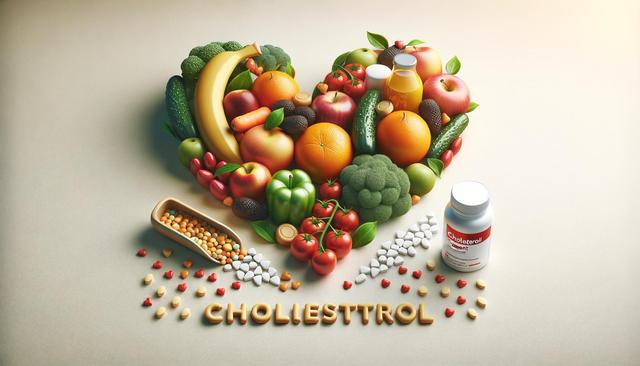Understanding the Link Between Diet and Cholesterol
Cholesterol levels are influenced by several factors, but what you eat plays a central role. When you consume foods high in saturated fats or trans fats, your body may produce more low-density lipoprotein (LDL), often referred to as ‘bad cholesterol.’ On the other hand, some foods actively help reduce LDL or raise high-density lipoprotein (HDL), the ‘good cholesterol.’ This is why focusing on a balanced diet is key. A cholesterol-lowering foods list can serve as a practical tool to guide your daily choices, especially if you’re trying to avoid medication or supplement your current treatment plan with natural strategies.
By understanding how specific ingredients work in the body, you can make informed decisions that support heart health. These natural foods to reduce cholesterol don’t just help with cholesterol—they often provide fiber, antioxidants, and other nutrients that benefit your overall well-being.
High Fiber Foods for Cholesterol Control
Dietary fiber—especially soluble fiber—binds to cholesterol in the digestive system and helps remove it from the body. Including high fiber foods for cholesterol management in your meals can lead to meaningful results over time. Soluble fiber is found in many plant-based ingredients that are easy to incorporate into daily meals.
Some examples of high fiber options include:
- Oats and oat bran
- Barley and other whole grains
- Legumes like lentils, beans, and peas
- Fruits such as apples, oranges, and pears
- Vegetables like carrots and Brussels sprouts
Consuming these foods regularly can help you maintain healthy cholesterol levels. High-fiber diets also contribute to stable blood sugar and support digestive health, making them a well-rounded choice for overall health improvement.
Incorporating Fruits and Plant-Based Foods
Among the most accessible and effective dietary changes is increasing your intake of fruits and vegetables. Many fruits that lower cholesterol do so by providing both fiber and antioxidants that support the body’s natural detoxifying processes. Berries, citrus fruits, and apples are all highly rated for their nutritional value and cholesterol-lowering potential.
Plant based foods to lower cholesterol cover a wide range of ingredients that are both heart-friendly and versatile. These include:
- Nuts and seeds (like almonds and flaxseeds)
- Soy products (such as tofu and soy milk)
- Leafy greens and cruciferous vegetables
- Avocados, rich in monounsaturated fats
These foods not only help manage cholesterol but also support weight control and reduce inflammation. Swapping animal-based meals with plant-based alternatives a few times a week can lead to noticeable improvements in lipid profiles.
Simple Substitutions That Make a Difference
Making small changes to your everyday eating habits can significantly impact your cholesterol levels. You don’t need to overhaul your entire diet overnight; start with manageable substitutions that align with your preferences and routine. Opting for natural foods to reduce cholesterol over processed or fried items is a solid first step.
Try these practical swaps:
- Replace butter with olive or canola oil
- Choose whole grain bread over white bread
- Use beans or lentils in place of red meat in soups and stews
- Snack on fruit or nuts instead of chips or cookies
Over time, these choices can reduce LDL cholesterol and improve your overall cardiovascular health. Plus, by focusing on whole ingredients, you’re likely to consume fewer added sugars and preservatives, which also supports heart health.
Combining Foods That Lower Cholesterol Fast
While no single food offers a quick fix, combining several cholesterol-friendly ingredients creates a cumulative effect that can make a difference faster. Following a varied diet that includes multiple items from the cholesterol lowering foods list ensures you’re covering all nutritional bases.
Some of the best foods to lower cholesterol work particularly well together. For instance, pairing oats with berries and flaxseeds for breakfast combines fiber, antioxidants, and healthy fats in one meal. Similarly, a salad with leafy greens, avocado, and a handful of walnuts brings together plant-based nutrients that support heart health.
Consistency is key. Eating these foods regularly—rather than occasionally—offers the best opportunity for improvement. Always consult with a healthcare provider, especially if you’re already on medication, to ensure dietary changes align with your overall treatment plan.
Conclusion: A Sustainable Approach to Cholesterol Management
Lowering cholesterol through food is not only possible but also sustainable with the right mindset and choices. By focusing on foods that lower cholesterol fast and incorporating high fiber foods for cholesterol control, you’re supporting your body in a natural and effective way. Whether you’re starting with fruits that lower cholesterol or exploring a plant-based eating style, these changes can fit into everyday life without overwhelming you.
Rather than seeking a one-size-fits-all solution, aim for ongoing improvements supported by a cholesterol lowering foods list tailored to your preferences. With consistent habits and informed choices, managing cholesterol becomes a realistic and empowering part of your wellness journey.




Leave a Reply